Author: Marianthi Kallidoni
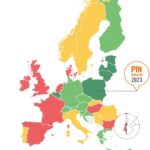
The European Transport Safety Council (ETSC) published the 17th edition of PIN Annual Report, with the active contribution of NTUA, presented at the 2023 ETSC Road Safety Performance Index Award event which took place with great success on 20 June 2023 in Brussels. The EU27 collectively reduced the number of road deaths by 22% over the period 2012-2022. The European Transport Safety Council (ETSC) has awarded its 2023 Road Safety Performance Index (PIN) Award to Poland for the first time, because the country cut road deaths by 47% between 2012 and 2022, a rate only bettered by Lithuania, last year’s winner. 
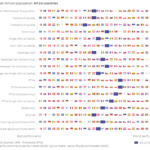
The new EU road fatalities interactive infographic of the NTUA Road Safety Observatory, based on European Commission CARE data for 2021, allows for performance comparisons for different types of road crashes. It is demonstrated that disaggregate data can reveal hidden road safety problems, allowing national Authorities to focus on targeted road safety countermeasures. 


The new Greek Regions interactive road fatalities Infographic of the NTUA Road Safety Observatory, based on ELSTAT data for 2021, allows for performance comparisons for different types of road crashes. It is demonstrated that disaggregate data can reveal hidden road safety issues, allowing national and local Authorities to focus on targeted road safety countermeasures. 

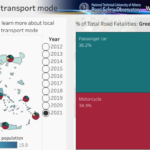
According to the Hellenic Statistical Authority (ELSTAT) road crashes data for 2021 in Greece, 36% of road fatalities are passenger car occupants, whereas 34% of road fatalities are power two wheelers. Most car occupant fatalities occur outside built-up areas, while most motorcycle and pedestrian fatalities occur inside built-up areas. 

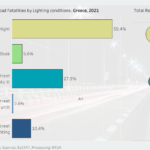
According to the latest Hellenic Statistical Authority (ELSTAT) data for 2021, most road fatalities in Greece occur at daytime, 346 out of 624 total fatalities. At night, inside built-up area with good street lighting occur 125 fatalities and outside built-up area with no street lighting occur 56 fatalities. 

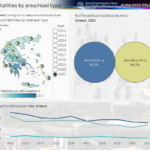
According to the Hellenic Statistical Authority (ELSTAT) data, among the 624 persons killed in Greece in 2021: 310 were outside built-up areas and 314 were inside built-up areas. Half of fatalities occurred in rural areas. The lowest percentage of fatalities occurs on motorways, despite the significant amount of vehicle kilometers driven. 

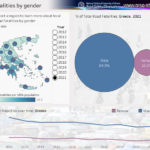
According to Hellenic Statistical Authority (ELSTAT) data, 624 persons were killed in Greece in 2021: 447 drivers, 82 passengers and 95 pedestrians. Males account for 81% of all road fatalities in Greece during the last decade. In 2021, there is no region with female fatality rate over 27%, while males aged 25-49 y.o. account for 33% of all road fatalities. 

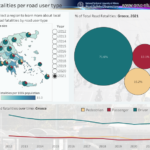
According to Hellenic Statistical Authority (ELSTAT) data, 624 persons were killed in Greece in 2021: 447 drivers, 82 passengers and 95 pedestrians. Since 2020, there is a slight increase in driver fatalities, from 68% to 72% of total road fatalities. In 2021, older pedestrians (65+) account for 44% of pedestrian fatalities and people aged 25-49 y.o. account for 37% of total fatalities. 

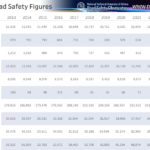
Road fatalities in Greece in 2022 presented a slight increase (2%) compared to 2021 figures, according to the provisional ELSTAT data. This slight increase is mainly attributed to the returning back to normal traffic from the pandemic period. During the last decade, Greece presented an impressive road safety improvement in the European Union, with a decrease of 28% in road fatalities since 2013 and a decrease of serious injuries of 48%. The rate fatalities per million vehicles has decreased by 33% since 2013. 

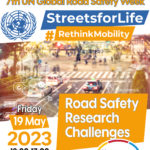
NTUA within the framework of the Seventh UN Global Road Safety Week organised with great success a Scientific Workshop titled “Road Safety Research Challenges” which was held in Athens (and online) on May 19th, 2023. The objective of this Workshop was to highlight through an intensive flow of presentations the main findings and challenges of key road safety research projects carried out within the NTUA Department of Transportation Planning and Engineering. 
 Workshop presentations:
Workshop presentations:
-
 NTUA Road Safety Observatory – nrso
NTUA Road Safety Observatory – nrso National Road Safety Strategy – Greece 2030 – nrss
National Road Safety Strategy – Greece 2030 – nrss Shared Automation Operating Models for Worldwide Adoption – Show
Shared Automation Operating Models for Worldwide Adoption – Show Holistic Approach for Driver Role Integration into Automation – Hadrian
Holistic Approach for Driver Role Integration into Automation – Hadrian Driver needs and behaviour in automated traffic – Drive2theFuture
Driver needs and behaviour in automated traffic – Drive2theFuture Driver-vehicle-environment interactions and safety tolerance zone – i-Dreams
Driver-vehicle-environment interactions and safety tolerance zone – i-Dreams Smart city mapping for safer and eco driver behaviour – SmartMaps
Smart city mapping for safer and eco driver behaviour – SmartMaps Smartphone applications for driver safety behaviour support – BeSmart
Smartphone applications for driver safety behaviour support – BeSmart Predictive Approaches for Safer Urban Environments – Phoebe
Predictive Approaches for Safer Urban Environments – Phoebe AI for Vision Zero in Road Safety – Ivory
AI for Vision Zero in Road Safety – Ivory E-Survey of Road users’ Attitudes – ESRA3
E-Survey of Road users’ Attitudes – ESRA3 Support to the European Road Safety Observatory – ERSOnext
Support to the European Road Safety Observatory – ERSOnext Support of technical activities for the development and collection of Road Safety KPIs – Trendline
Support of technical activities for the development and collection of Road Safety KPIs – Trendline National Access Point Coordination Organisation for Europe – Napcore
National Access Point Coordination Organisation for Europe – Napcore A Methodology for Network-wide Road Assessment – NetSafety
A Methodology for Network-wide Road Assessment – NetSafety Modelling road infrastructure safety – i-SafeModels
Modelling road infrastructure safety – i-SafeModels Global Road Safety Knowledge Exchange – Piarc
Global Road Safety Knowledge Exchange – Piarc Micromobility Safety: Back to the Future – Mimob
Micromobility Safety: Back to the Future – Mimob Unsafe traffic events – Ute
Unsafe traffic events – Ute Promoting 30km/h speed limit in all Cities – 30 Marathons in 30 months
Promoting 30km/h speed limit in all Cities – 30 Marathons in 30 months

Τhe European Transport Safety Council (ETSC) is calling for the European Union and European national governments to make Anti-lock Braking Systems (ABS) mandatory on all new motorcycles in a new report, titled Reducing Road Deaths among Powered Two Wheeler Users. This Report examines the state of motorcycling safety in Europe and revealed that 3,891 people died while riding a motorcycle or moped in the EU in 2021. That figure is 25% lower than a decade earlier but, over the same period, other road deaths fell by a third. 


The NTUA Department of Transportation Planning and Engineering organised with great success a Scientific Workshop titled “Telematics and Driver Behaviour” which took place in Athens on April 4th, 2023. Key driver telematics research findings were demonstrated and discussed, highlighting spectacular safety benefits from monitoring, evaluation and improvement of driver behaviour through feedback tools, social gamification schemes and motivation for drivers.  Workshop Presentations:
Workshop Presentations:
 Telematics, Big Data and Road Safety – nrso
Telematics, Big Data and Road Safety – nrso Improving driving behaviour through OSeven’s telematics application – Oseven
Improving driving behaviour through OSeven’s telematics application – Oseven Key road safety and telematics data – i-Safemodels
Key road safety and telematics data – i-Safemodels Development of a global road safety model – i-Safemodels
Development of a global road safety model – i-Safemodels Exploiting surrogate safety measures and road design characteristics towards crash investigations in motorway segments – i-Safemodels
Exploiting surrogate safety measures and road design characteristics towards crash investigations in motorway segments – i-Safemodels A crash hotspot identification and safety ranking methodology – i-Safemodels
A crash hotspot identification and safety ranking methodology – i-Safemodels State of the art on spatial analysis and visualization tools for potential telematics applications – SmartMaps
State of the art on spatial analysis and visualization tools for potential telematics applications – SmartMaps Spatial analysis of telematics surrogate safety measures across road environments – SmartMaps
Spatial analysis of telematics surrogate safety measures across road environments – SmartMaps From understanding the effects of driving behaviour on fuel consumption to a personalized eco-recommendation system – EcoDrive
From understanding the effects of driving behaviour on fuel consumption to a personalized eco-recommendation system – EcoDrive A personalized framework for fuel efficient route planning – EcoDrive
A personalized framework for fuel efficient route planning – EcoDrive The transformation of the insurance industry and road safety by driver safety behaviour telematics – BeSmart
The transformation of the insurance industry and road safety by driver safety behaviour telematics – BeSmart Investigating the impact of COVID-19 pandemic on driver behaviour through telematics data – Covid-19
Investigating the impact of COVID-19 pandemic on driver behaviour through telematics data – Covid-19 Effectiveness Evaluation of the i-DREAMS Interventions – i-Dreams
Effectiveness Evaluation of the i-DREAMS Interventions – i-Dreams Modelling the inter-relationship between task complexity, coping capacity and crash risk – i-Dreams
Modelling the inter-relationship between task complexity, coping capacity and crash risk – i-Dreams Telematics, microsimulation and road safety assessment requirements for the enhancement of analytic tools – Phoebe
Telematics, microsimulation and road safety assessment requirements for the enhancement of analytic tools – Phoebe

NTUA Professor George Yannis, after more than 30 years of dedication to road safety science and several Marathon races, decided to combine both passions for a cause: to run 30 Marathons in 30 months in order to actively promote the adoption of 30km/h speed limit in as many cities as possible worldwide, as a fundamental policy for safer, healthier and greener cities for all. Speeding is the number one cause of road crashes worldwide and the active promotion of 30 km/h cities can save 50% of lives lost today. 





The Department of Transportation Planning and Engineering of Civil Engineering School at the National Technical University of Athens was ranked 4th in Europe this year and 26th worldwide among all Transportation Departments, with the best performance among all NTUA Departments. This ranking is produced by EduRank‘s final score based on three parts: 45% Research performance, 45% Non-academic prominence and 10% Alumni score. NTUA road safety activities have significantly contributed to this ranking.
Departments’ Director George Yannis stated that: “the persistence in scientific excellence of our highly qualified transportation engineers contributes to a future with efficient, green and safe transport systems in Greece, in Europe and globally”. 

The Hellenic Ministry of Infrastructure and Transport produced for the first time ever Road Safety Key Performance Indicators (KPIs) for all key crash risk factors in Greece, with the active contribution of NTUA. The five KPIs related to road user behavior concern speeding, seatbelt use, helmet use, driving under the influence of alcohol and distraction and demonstrate the basic causes of road crashes in Greece. These KPIs have been incorporated at the new National Road Safety Plan of Greece in order to identify key road safety problems in Greece and to determine the respective solutions, but also for the setting of the 8 road safety KPI targets for the decade (e.g. helmet wearing rate from 79% today, to 90% in 2025 and 95% in 2030). 
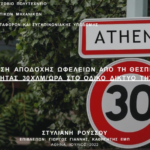
An NTUA Diploma Thesis titled “Cost benefit and acceptance analysis of reducing speed limits in Athens to 30km/h” was recently presented by Stella Roussou. This Diploma modeled Athenians preferences on speed limit reduction and performed the respective socio-economic cost benefit analysis (CBA) of the reduction of crashes and respective casualties, the costs incurred due to the increase in travel time and the benefit from reducing fuel consumption and environmental impact (CO2, NOx, PM emissions). The CBA revealed that the 30km/h speed limit is deemed economically highly viable and worth of implementing. 


The Horizon 2020 project i-DREAMS (smart Driver Environment Assesment and Monitoring System) recently released its 5th Newsletter, presenting the main accomplishments of the project, through creative solutions and risk mitigation strategies, exploiting state-of-the art findings on driver safety tolerance zone. The Newsletter presents how to bring i-DREAMS to the market and society, the second successful review meeting and several i-DREAMS dissemination activities. 


The Ministry of Infrastructure and Transport developed the National Road Safety Strategic Plan for the period 2021-2030, with the scientific support of the Department of Transport Planning and Engineering of the National Technical University of Athens (NTUA). The National Road Safety Strategic Plan 2021-2030 exploits state-of-the-art international experience and good practice, adjusted to the Greek reality and contains a set of 44 actions and 200 measures with concrete budget and timeplan addressing the key road safety problems in Greece: speeding and motorcycle traffic; aiming to meet the quantitative targets set for the reduction of the number of fatalities and serious injuries in road crashes by 50% by 2030. Within the current final open consultation process you are welcome to submit your remarks and comments. 


A paper titled “Modelling the relationship between covid-19 restrictive measures and mobility patterns across Europe using time-series analysis” authored by Marianthi Kallidoni, Christos Katrakazas and George Yannis is published in European Journal of Transport and Infrastructure Research. Data on walking and traffic were exploited and several time series analysis models were developed, in order to estimate mobility during pandemic in 25 EU countries. School closing was found to be the most important exogenous factor for describing driving or walking, while “Stay at home” orders had not a significant effect on the evolution of people movements. 














































































































































































